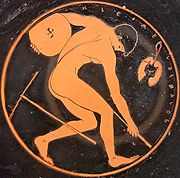
Kalos inscription
Encyclopedia

Epigraphy
Epigraphy Epigraphy Epigraphy (from the , literally "on-writing", is the study of inscriptions or epigraphs as writing; that is, the science of identifying the graphemes and of classifying their use as to cultural context and date, elucidating their meaning and assessing what conclusions can be...
found on Attic vases and graffiti in antiquity, common between 550 and 450 BC, and usually found on symposion
Symposium
In ancient Greece, the symposium was a drinking party. Literary works that describe or take place at a symposium include two Socratic dialogues, Plato's Symposium and Xenophon's Symposium, as well as a number of Greek poems such as the elegies of Theognis of Megara...
vessels. The word καλός means "beautiful"; here it had an erotic connotation, and the inscription took the form of a youth's name, in the nominative singular, followed by "kalos" ("X kalos", i.e. "X is beautiful"). The individuals mentioned were almost always teenage boys, though occasionally girls and women were spoken of as καλή (kalē). Kroll reports that ceramic descriptions of individuals labeled as beautiful include thirty of women and girls, kalē, and five hundred and twenty eight of boys, kalos. Kalos names are also found as graffiti on walls, the most abundant example being the find on Thassos of 60 kalos inscriptions carved on rock dating from the 4th century. The non-epigraphic literary evidence consists of two references in Aristophanes, line 144 in the Archarnians and lines 97-99 in the Wasps. In both of these instances, it is the demos that is lauded rather than any individual, and strongly suggest the public performance role of the kalos tag.
Some kalos inscriptions are associated with certain vase painters and potters; the Antimenes Painter
Antimenes painter
The Antimenes Painter was an Attic vase painter of the black-figure style, active between circa 530 and 510 BC.The real name of the Antimenes Painter is not known; his current name is an archaeological convention. It is derived from the Kalos inscription on a hydria in Leyden. Of the 150 works...
is named after the kalos inscription for Antimenes on his pots. It is thought that since the names referred to were largely aristocratic citizens and that certain pottery workshops are associated with some kalos recipients (i.e. the Leagros Group named after the youth Leagros) they may have been the expression of a cult of celebrity or part of a concerted effort by the youths' families to increase their sons' public standing. Another possibility is that they were declarations of love on the part of the author in the style of courtship.
The purpose of these inscriptions is uncertain, principally they are thought to be declarations of love on the part of the author for the young man in question. In a few cases, they were probably written according to the specific wishes of a customer. Beyond that, to which audience the inscription was addressed, what effect it was meant to have, how it was meant to achieve this effect, and how successful this mode of communication was, is unclear.
Sources
- Neil W. Slater. 'The Vase as Ventriloquist: Kalos-inscriptions and the Culture of Fame', in Signs of Orality: The Oral Tradition and its Influence in the Greek and Roman World (ed. E. Anne Mackay). Leiden: Brill, 1999, pp. 143-161.
- Kenneth J. Dover. Greek Homosexuality. 2nd edition. London: Duckworth, 1989.
- François Lissarrague. Publicity and performance. Kalos inscriptions in Attic vase-painting, In: Performance Culture and Athenian Democracy, Cambridge 1999, pp. 359-373.
- H. Alan Shapiro. Leagros the Satyr in Greek Vases: Images, Contexts and Controversies., ed. Clemente Marconi, 2004, pp. 1-12.

